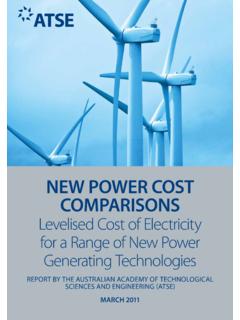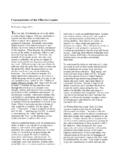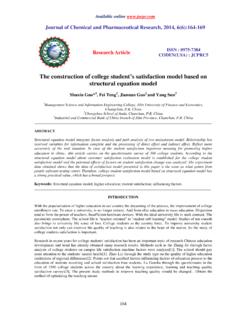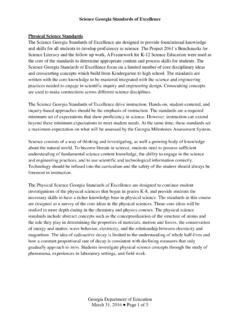Transcription of Developments in technology cost drivers – …
1 Thejd Jenny Hayward and Paul Graham March 2011 Developments in technology cost drivers dynamics of technological change and market forces Enquiries should be addressed to: Paul Graham CSIRO Energy Transformed Flagship PO Box 330, Newcastle NSW 2300 Phone: +61-2-49606061 Email: Copyright and Disclaimer 2011 CSIRO To the extent permitted by law, all rights are reserved and no part of this publication covered by copyright may be reproduced or copied in any form or by any means except with the written permission of CSIRO. Important Disclaimer CSIRO advises that the information contained in this publication comprises general statements based on scientific research.
2 The reader is advised and needs to be aware that such information may be incomplete or unable to be used in any specific situation. No reliance or actions must therefore be made on that information without seeking prior expert professional, scientific and technical advice. To the extent permitted by law, CSIRO (including its employees and consultants) excludes all liability to any person for any consequences, including but not limited to all losses, damages, costs, expenses and any other compensation, arising directly or indirectly from using this publication (in part or in whole) and any information or material contained in it. i Contents 1.
3 Executive 3 2. Introduction .. 4 3. drivers of cost reductions: technological change and experience curves .. 4 4. drivers of cost increases: engineering adjustments and market forces .. 5 Case study 1: wind power cost increases .. 7 Case study 2: solar photovoltaic cost 9 5. Conclusion and implications .. 11 References .. 14 ii Lis t o f Figures Figure 1: change in CSIRO current electricity generation plant price estimates. Data from (Graham et al., 2008, Reedman et al., 2008, Reedman et al., 2006b, Reedman et al., 2006a, Graham et al., 2003, Graham and Williams, 2003, Cottrell et al., 2003, Graham and Williams, 2001, Dave et al.)
4 , 2008) .. 6 Figure 2: Wind turbine price and annual installations in IEA countries. Data from (International Energy Agency, 2000-2009) .. 7 Figure 3: Steel price index. Data from (CRU, 2010) .. 8 Figure 4: Photovoltaic module price and capacity trends (Data from (Energy Efficiency and Renewable Energy, 2010, J ger-Waldau, 2010, European Photovoltaics Industry Association, 2010, International Energy Agency, 1993-2009) .. 10 Figure 5: Photovoltaic module price and silicon stock and demand trends (Data from (Braga et al., 2008, Energy Efficiency and Renewable Energy, 2010) .. 11 Figure 6: Options for forecasting technology prices during a price bubble or dip phenomenon.)
5 13 EXECUTIVE SUMMARY Developments in technology cost drivers dynamics of technological change and market forces 3 1. EXECUTIVE S UMMAR Y The process of technological change is often expressed as an experience or learning curve, where the cost of the technology decreases by an historically measured percentage ( learning rate) for every doubling of cumulative capacity or output. As more capacity is installed in the future, the cost can be projected to fall over time. However, recent experience of increased real power plant prices has reminded us that other drivers can at times exert a stronger influence on the price trajectory.
6 In seeking to understand recent technology price increases, one possible explanation explored is whether a revision of bottom-up engineering costs had occurred due to new information about the real costs of building first of a kind plant. However, given that the price increases have occurred across not just emerging but also mature technologies for which there are decades of plant construction experience, this explanation does not appear plausible. The data from two case studies explored in this paper strongly supports the proposal that market forces have been the main driving force behind the increased cost of electricity generation technologies.
7 Market forces come in two separate but related guises. The first is changes in raw material costs used in construction of the power plant. The second is where there is a supply-demand imbalance in the market for the power plant itself. These effects can be difficult to distinguish from one another when demand for a power plant is strong, affecting both the power plant and raw material markets. These power plant market forces which in the past five years have manifested as a price bubble on top of the ordinary cost curve could equally manifest as a price dip if circumstances contrived to create a depressed market for power plants and their raw materials.
8 It is also very difficult to predict how long a bubble or dip might last. There might also be cause to believe some price changes might be permanent due to fundamental changes in market structure ( extended minerals shortages). The presence of such uncertainties around the effects of market forces creates a challenge for cost forecasters. If a price bubble is suspected, it is important to have a methodology for eventually adjusting the price back down to the underlying cost curve. Otherwise the future price of the technology may be over-estimated. INTRODUCTION 4 2. INTRODUCTION In the study of future technology costs, the conventional assumption is that technologies will cost less (in real terms) in the future due to learning and experience, encompassing factors such as technological change and economies of scale.
9 However, contrary to expectations, the costs of most electricity generation technologies have increased in real terms in the past five years. This briefing provides a discussion of the factors behind this phenomenon and their implications for expectations of future costs. The report was prepared as input to the Garnaut Review Update in a relatively short time frame, and therefore is not intended to be comprehensive. 3. drivers OF COS T REDUCTIONS : TECHNOLOGICAL CHANG E AND EXPERIENCE CUR VE S The phenomenon of technology learning has been observed for the development of new technologies and processes since the 1930 s when it was noted by Wright for airplane production (Wright, 1936) and later more extensively by the US Air Force for airframe production (Alchian, 1949, Hirsch, 1956).
10 The term learning -by-doing was coined by Arrow (Arrow, 1962) and was used to explain the effect increasing the knowledge or experience of the labour force had on the economics of production of technology and processes (improvements in per capita income). Gr bler et al (1999) discussed and demonstrated how technology learning and diffusion for energy technologies can be incorporated into economic models of electricity generation. (Schrattenholzer and McDonald, 2001) calculated experience curves and rates of learning for many energy-related technologies as, up until then, learning rates from other technologies (Dutton and Thomas, 1984) were being used.









